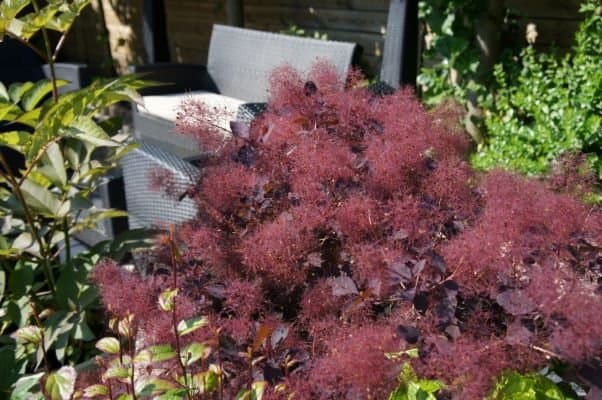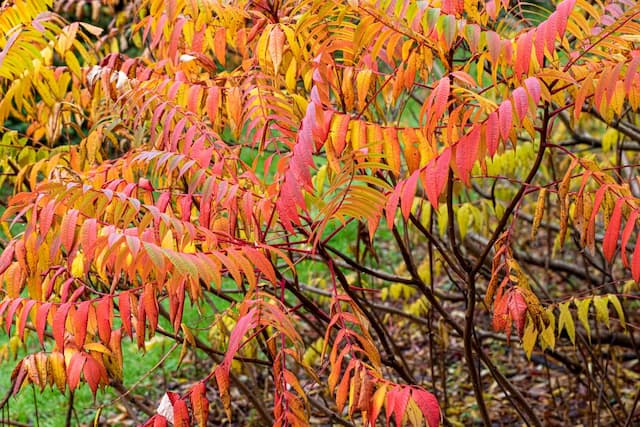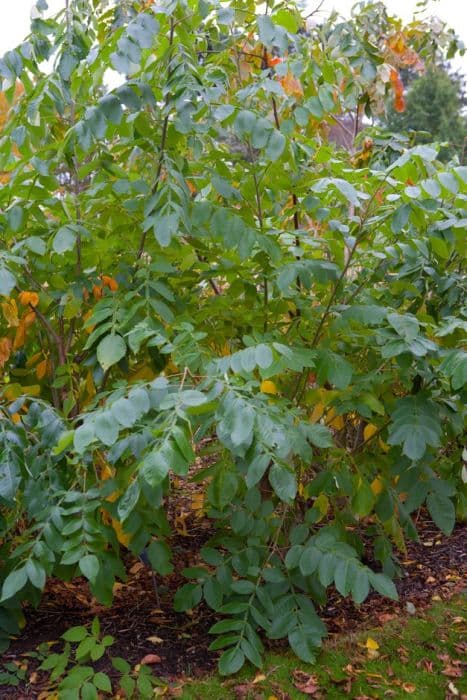Staghorn Sumac Rhus typhina Radiance = 'Sinrus'
![stag's horn sumach [Radiance]](/_next/image?url=https%3A%2F%2Fplants-admin.emdemapps.com%2Fimages%2Fplants%2F%2Fimages%2F604b6223f1c1d.png&w=3840&q=75)
ABOUT
The plant known as Staghorn sumac 'Radiance' is a striking deciduous shrub, notable for its distinctive foliage and vibrant seasonal color changes. The leaves are large, compound, and dissected into many smaller leaflets which are arranged in a feather-like pattern along the central stem. In spring and summer, the foliage is a fresh green hue, but as the seasons shift to autumn, the leaves undergo a dramatic transformation. They turn into a fiery display of oranges, reds, and yellows, lighting up the landscape with warm tones. In addition to the colorful foliage, Staghorn sumac 'Radiance' is recognized for its unique fruiting structures. The plant produces dense clusters of tiny, velvety berries, which stand upright above the foliage. These berry clusters are initially green, but they become a deep red as they mature, persisting through the winter and providing a striking contrast against the barren winter landscape. The reddish-pink berry clusters are not only visually appealing but also attract wildlife, offering a source of food for birds. The bark and stems of the Staghorn sumac 'Radiance' further contribute to the plant's ornamental charm. The young stems exhibit a fine, velvety texture, similar to that of a deer's antlers in the early stages of growth, from which part of its common name is derived. Over time, the bark becomes rough and deeply fissured, adding textural interest even in the dormant season when leaves are absent. This sumac's branching pattern is also noteworthy, as it tends to grow with a spreading, open habit. This gives the plant a somewhat architectural look, with branches reaching outwards and upwards in a manner that provides visual interest in the landscape year-round. The Staghorn sumac 'Radiance' is a robust and adaptable plant, well-suited for adding a touch of drama to gardens and naturalized areas with its alluring features and dynamic seasonal changes.
About this plant
 Names
NamesSynonyms
Staghorn Sumac, Velvet Sumac, Hairy Sumac.
Common names
Rhus hirta Radiance, Rhus typhina var. hirta Radiance.
 Toxicity
ToxicityTo humans
Staghorn sumac is generally not considered toxic to humans; in fact, certain parts of the plant have been traditionally used in making beverages and spices. However, like other members of the Rhus genus, staghorn sumac can cause allergic reactions in sensitive individuals, similar to poison ivy, due to the presence of urushiol oil in the plant's sap. Contact with the sap can lead to dermatitis or a skin rash upon contact. Ingestion is not typically associated with serious toxicity, but it could potentially cause stomach irritation or discomfort in some people. It is advisable to handle staghorn sumac with care, especially if you have sensitive skin or known allergies to urushiol-containing plants.
To pets
Staghorn sumac is not known to be toxic to pets. Pets, like cats and dogs, might experience mild gastrointestinal upset if they consumed parts of the plant, mainly if they are not accustomed to it. However, as with humans, the main concern comes from the potential skin irritation that could result from contact with the plant's sap, which contains urushiol. While not poisonous, it is still best to discourage pets from chewing on or eating staghorn sumac to prevent any possible discomfort or allergic reactions.
 Characteristics
CharacteristicsLife cycle
Perennials
Foliage type
Deciduous
Color of leaves
Mixed
Height
15 feet (4.57 meters)
Spread
15 feet (4.57 meters)
Plant type
Shrub
Hardiness zones
4
Native area
North America
Benefits
 General Benefits
General Benefits- Aesthetic Appeal: Adds visual interest to gardens with its vibrant foliage and distinct architectural form.
- Wildlife Habitat: Provides food and shelter for birds and other wildlife.
- Erosion Control: Helps stabilize soil and prevent erosion with its robust root system.
- Low Maintenance: Requires minimal care once established, making it ideal for low-maintenance landscapes.
- Drought Tolerance: Can survive in dry conditions once mature, suitable for xeriscaping.
- Fall Color: Displays striking fall colors that enhance the seasonal interest of the landscape.
 Medical Properties
Medical Properties- This plant is not used for medical purposes.
 Air-purifying Qualities
Air-purifying QualitiesThis plant is not specifically known for air purifying qualities.
 Other Uses
Other Uses- Dye Production: The bark of the Rhus typhina Radiance (Staghorn Sumac) can be used to produce a natural dye, useful for coloring textiles or crafts.
- Leather Tanning: The high tannin content in the leaves and bark can be utilized in the tanning process to prepare and preserve leather.
- Ink Making: Historically, the tannins from the Staghorn Sumac were potentially used to make ink.
- Culinary Spice: The dried and ground drupes (sometimes referred to as sumac spice) are used in Middle Eastern cuisine to add a tart, lemony taste to dishes.
- Furniture Material: The wood is sometimes used in furniture making for small items such as decorative wooden bowls or handles for tools due to its interesting texture.
- Erosion Control: Staghorn Sumac's robust root system makes it useful for controlling erosion on steep slopes or banks.
- Habitat Restoration: The species is often used in reforestation and habitat restoration projects because it grows quickly and provides cover for wildlife.
- Photography: The striking appearance of the Staghorn Sumac in different seasons makes it a favored subject for nature photographers, especially when the foliage changes color.
- Soil Improvement: In some areas, they are used to improve soil quality due to their ability to fix nitrogen in the soil.
- Landscape Design: Staghorn Sumac's unique form and vibrant fall colors are often utilized as a focal point in landscape design, enhancing the aesthetic of ornamental gardens.
Interesting Facts
 Feng Shui
Feng ShuiThe Staghorn Sumac is not used in Feng Shui practice.
 Zodiac Sign Compitability
Zodiac Sign CompitabilityThe Staghorn Sumac is not used in astrology practice.
 Plant Symbolism
Plant Symbolism- Resilience: The plant's ability to grow in a variety of conditions symbolizes resilience and the capacity to adapt to different environments.
- Healing: Historically, parts of the plant have been used for medicinal purposes, representing healing and the alleviation of ailments.
- Protection: In some cultures, plants of the Rhus genus are considered protective, symbolizing shelter and safety against harm.
- Renewal: The plant's capacity for new growth, especially after being cut back, embodies the concept of renewal and fresh beginnings.
 Water
WaterStaghorn sumac should be watered deeply but infrequently, establishing a strong routine for the roots to grow deep and resist drought. For newly planted sumacs, water them twice a week with approximately 1-2 gallons depending on the size of the plant and weather conditions. Once established, they require less frequent watering, and you can reduce watering to once every two weeks if there is no significant rainfall, providing 1-2 gallons each time depending on the dryness of the soil.
 Light
LightStaghorn sumac thrives best in full sunlight, which means it should receive at least 6 hours of direct sun daily. The ideal spot for this plant would be an open area without shade from buildings or other trees to ensure it gets plenty of sunlight throughout the day. They can tolerate partial shade, but their fall color and overall growth might not be as vibrant.
 Temperature
TemperatureStaghorn sumac is a hardy plant that can tolerate a wide range of temperatures, surviving winter lows down to around -30°F and summer highs exceeding 100°F. The ideal temperature conditions for this plant are between 60°F and 80°F, where it can grow vigorously and produce its distinct foliage and fruit.
 Pruning
PruningPrune staghorn sumac to shape the plant, remove any dead or damaged wood, and encourage new growth. The best time for pruning is late winter or early spring before new growth begins. Pruning can be done every year, but is not strictly necessary unless the plant is becoming too large or unruly. Remember to make clean cuts and not to over-prune, as it could damage the plant's natural form.
 Cleaning
CleaningAs needed
 Soil
SoilStaghorn sumac 'Radiance' prefers well-draining soil with a pH range of 5.5 to 7.0. A mix of loam, coarse sand, and peat can create ideal conditions. Organic matter like compost can enhance soil fertility for optimal growth.
 Repotting
RepottingStaghorn sumac 'Radiance' typically doesn't require frequent repotting as it's a large shrub and often planted directly in the ground. Repot only if it outgrows its container or every 3-5 years.
 Humidity & Misting
Humidity & MistingStaghorn sumac 'Radiance' is adaptable and does not require specific humidity conditions; it tolerates a broad range of outdoor humidity levels well.
 Suitable locations
Suitable locationsIndoor
Ensure bright light; not ideal for long-term indoor growth.
Outdoor
Full sun, well-draining soil; space well for growth.
Hardiness zone
4-8 USDA
 Life cycle
Life cycleThe Staghorn sumac (Rhus typhina 'Radiance') begins its life cycle when the seeds germinate, typically in the spring following a period of cold stratification that breaks seed dormancy. After germination, the seedlings grow rapidly into young plants, developing compound leaves and a distinctive, hairy stem evocative of deer antlers in velvet. Given the right conditions, by the second or third year, the Staghorn sumac will mature and begin producing flowers; the male and female flowers are usually on separate plants. By late summer, female plants produce dense clusters of crimson drupes that persist into winter, providing food for wildlife. The plant also expands through its underground rhizome system, which causes the growth of new shoots around the parent plant and can lead to the formation of thickets. Over many years, this deciduous shrub can reach up to 25 feet in height, and it will continue to grow, reproduce, and spread until it reaches the end of its life span, which can be several decades under optimal conditions.
 Propogation
PropogationPropogation time
Spring-Early Summer
Propogation: The most popular method of propagating Staghorn Sumac 'Radiance' is through root cuttings. This involves excavating around the base of the mature plant to locate young, pencil-sized roots. The chosen roots are cut into sections approximately 3 to 6 inches (7.6 to 15.2 centimeters) long. These cuttings are then planted in moist, well-draining soil, ensuring that they are kept horizontal or with the end that was closest to the plant base in the upward position. It's ideal to take these cuttings during the plant's dormancy period, which corresponds to late winter or early spring. After planting, the cuttings should be watered regularly to maintain consistent soil moisture until they establish a new root system, after which they can produce new shoots and ultimately mature into separate Staghorn Sumac plants.




